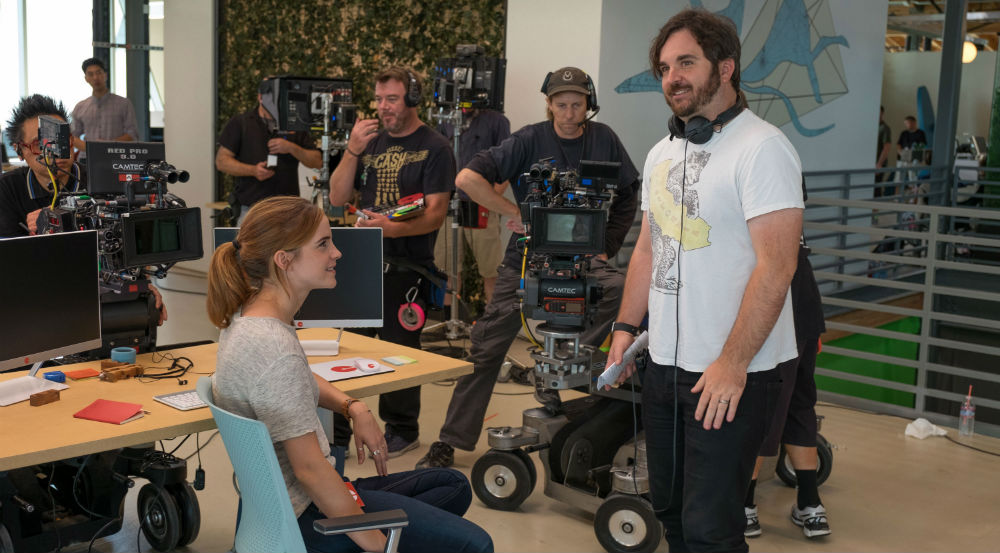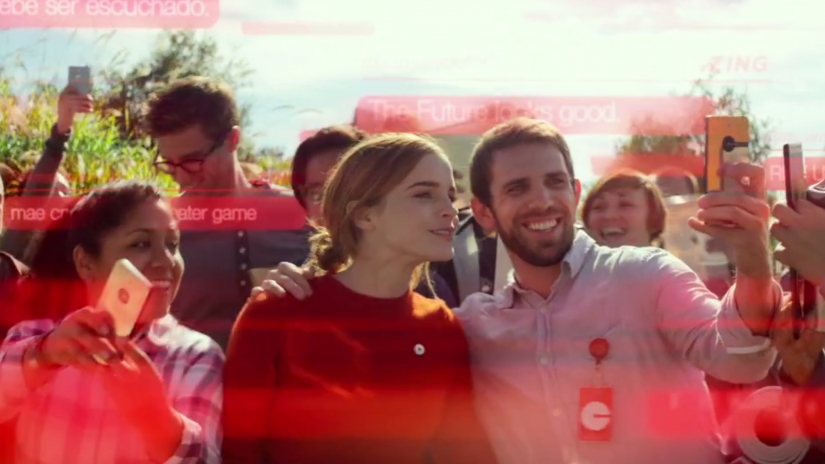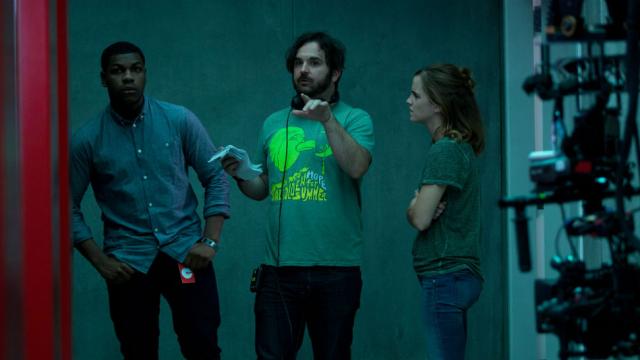Creating a fictional company that’s basically Facebook, Google and Apple rolled into one is no easy task. We know those brands. We live those brands. But in The Circle, co-writer and director James Ponsoldt had to do just that.
Director James Ponsoldt, centre, with his stars John Boyega and Emma Watson, on the set of The Circle. All Images: STX
Premiering in Australian theatres today, The Circle is based on the 2013 novel of the same name by Dave Eggers. It stars Tom Hanks as the leader of the titular tech giant and Emma Watson as its newest employee, who’ll soon become its most prominent too. It was in Watson’s character, Mae, that Ponsoldt first found a connection to the material.
“I saw myself in Mae,” the director told Gizmodo. “Her creeping anxiety, feeling like she’s not participating enough, not doing enough, was one that I could recognise. And I think also the feeling that she had some obligation to give up herself or share herself more than she was comfortable, was one that automatically upset me.”
We all think about these things every day when we post an image on Instagram or change our status on Facebook. So Ponsoldt took those feelings and poured them into adapting Eggers’ book without the author even knowing. He wasn’t even paid for it to start. But he eventually got the script to the author and Eggers liked it so much, he passed it along to Tom Hanks. From there it was off to the races.
In The Circle, Eggers creates a company that has eaten all its competitors. It’s everything you love about the internet and technology, all rolled into one. Which is fine on the page, but in a movie, you have to see that kind of thing and believe this company is better than all the giants we use on a daily basis. Doing that, while not losing the focus of the movie, was a huge challenge for Ponsoldt as writer and director.
“I wanted to depict tech in a way that felt like it was in the background of the story with the characters in the forefront,” he said. “And also, design it from the ground up so that it only really exists in our movie.”
Throughout the film, the audience never gets a full picture of what The Circle is or how it works. We see it, people use it, they have Circle phones and cameras, but you never get a full walkthrough — which makes sense because if the filmmakers actually figured out a site or tech that works as well as The Circle works, they could leave their Hollywood jobs for Silicon Valley. What you do get is a look at The Circle’s offices, which have to be equally as impressive for a company that size.

“We needed to think about what the real soul of this place was,” Ponsoldt said. “We did a lot of research, just visiting different tech campuses and looking at everything from, is everyone sitting or is everyone standing? Are they on treadmills? Is it an open floor plan? Is there glass in their private offices? Is there music? Have they personalised their desks? We wanted to get to the DNA of all those places. Are the meals free? Free concerts? Things like that.”
And so The Circle has a very heightened, big time tech campus vibe. But what’s that vibe without the people? Ponsoldt eventually realised they could design the most beautiful sets ever, but it had to be filled with the right attitude.
“I think what struck us was the friendliness,” he said. “The almost aggressive friendliness, earnestness and perkiness of the company. The sort of poppy, friendly bright quality as opposed to the cold, formal black and white, symmetrical dystopian qualities of it.”
And you don’t get that creepy kindness from an older crowd. In The Circle, almost all the employees are young. Someone even makes a joke that no one at the company has kids. It creates an eerie aesthetic which Ponsoldt believe fit in perfectly with what The Circle would actually be.
“This is a youth-dominated industry where you can be an elder statesman by your early 30s and ancient if you’re in your 40s,” Ponsoldt said. “And I think these campuses are wonderful. They’re all glass and shiny and free food and you can sleep there if you wanted, you feel like you’re at a giant park. And the work/home life line just blurs. Why would you leave? It’s great. And I think treating your workers right helps you get them to do more work for you. But that’s also time they don’t get to make real relationships, have kids and be actual parents to those kids. So part of it is their own choice.”
Besides the physical campus, one aspect of The Circle that does get some prominence in the movie is its online social interactivity. As Mae moves through her new life, the film almost constantly shows comments onscreen, from people off screen, who are watching Mae. And like you’d expect from most internet discussion threads, those responses run the gamut: Funny, sad, creepy, disturbing, in all languages imaginable. It was important for Ponsoldt that the film’s chorus of commenters not only be varied but also international, just like the web itself.

Here’s a bit of what the comments in the movie look like.
“We tried to find the perfect pitch where you can only read one or two, but not so much that you’re totally taken out of the scene and they have obliterated the frame,” Ponsoldt said. He revealed that while he wrote most of the comments himself, Dave Eggers wrote several, as did Patton Oswalt and some of the producers. “It was obsessive,” he said. “And we constantly changed it and realised people really hung on, looking at it a lot.”
As you can probably tell, painstaking detail was paid to making The Circle a believable tech company. But none of that matters if Ponsoldt didn’t deliver on the main point of the film: To get audiences to think about their own privacy.
“I personally am pro-technology. I’m pro-exploring outer space, the bottom of the sea, curing cancer, all of these connecting the world. These are all great things. But nowhere in that does it say that everyone should be surveilled, monitored, have their private information gathered and perhaps sold off to the highest bidder,” Ponsoldt said. “The truth is, most people don’t think about these things, or think that if you’re in dialogue with them, in a movie, you might be a technophobe. But it’s like, no, you should be talking about these things. It’s your stuff. It’s your identity. It’s your human rights.”
